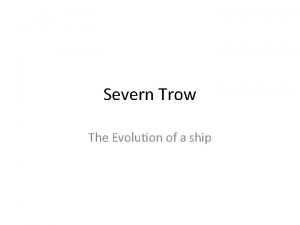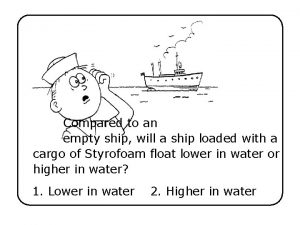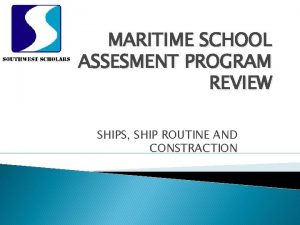Severn Trow The Evolution of a ship The






- Slides: 6

Severn Trow The Evolution of a ship

• The Severn trow (the name rhymes with ‘crow’) was a cargo-carrying craft that was unique to the River Severn and its estuary. • The name comes from the Saxon word ‘trog’ which means ‘trough’. • This describes the craft’s basic internal shape. • Trows were in use for over 800 years – possibly much longer. • 4 main types evolved, which demonstrate how ships have tended to increase in size over time.

Early Trow • Used from early medieval period to around 1500. • Mainly river craft, common between Newnham to the upper reaches of the Severn in the Midlands. • Probably developed from the ‘Knarr’ type of Viking longships. • Had a flat bottom to cope with the shallow waters of the river. • Most were probably towed from the bank or rowed rather than sailed. • About 10 m long and 2 m wide; could carry around 8 -10 tonnes of cargo.

Upriver trow • In use by Tudor times. • Had blunter bow and flat stern plus a single large square-sail. • Sailed into the tidal waters of the estuary as far south as Bristol. • Most were around 18 m long and 4 m wide and could carry on the order of 20 -40 tons of cargo. • Many specialised types came into use, such as the Wye barge, Stroud barge, Wych barge (which carried salt from Droitwich) and the Avon stone barge.

Estuarine trow • In use by 1850. • Better suited to sailing in the Severn Estuary and also in adjacent coastal waters. • Had fore-and-aft sails (these pointed along the boat rather than across it) • Had a deeper, broader hull. • Had a canvas covered hold to prevent water entering in rough seas • Usually around 20 -25 m long and 5 -6 m wide. They could generally carry on the order of 50 -60 tons of cargo.

Sea-going trow • • • The final version of the trow came into use from 1900. Had higher sides, more decking and wooden hatches over the hold to prevent any water entry in rough weather. Most only slightly bigger than estuarine trows but could carry more cargo, around 100 tons. Were used well into the 20 th century and the last sea-going sailing trow did not cease working until 1939. Some were later converted into barges that were towed behind powered craft and as such were used into the 1950 s. Today only a single trow, the Spry, survives and has been restored at Ironbridge Museum.











